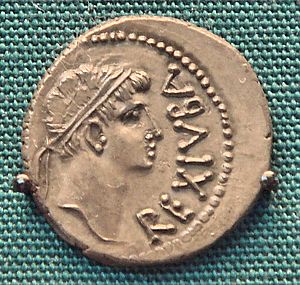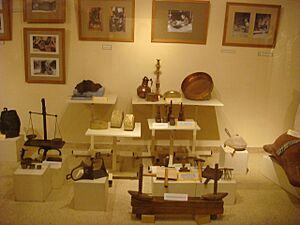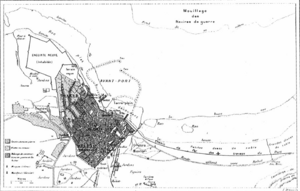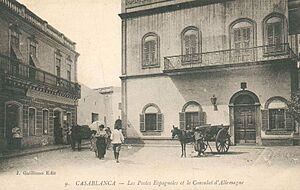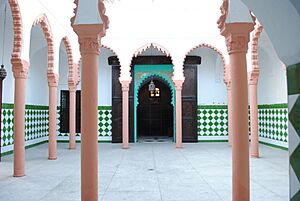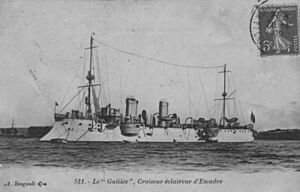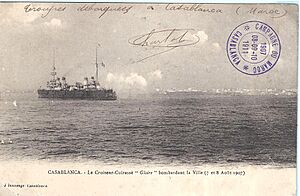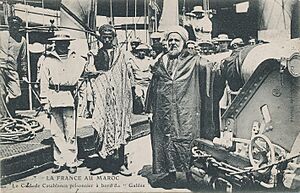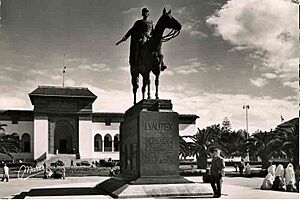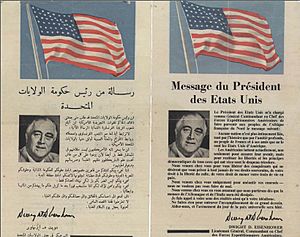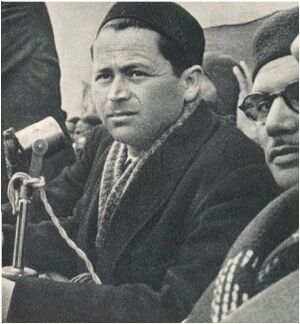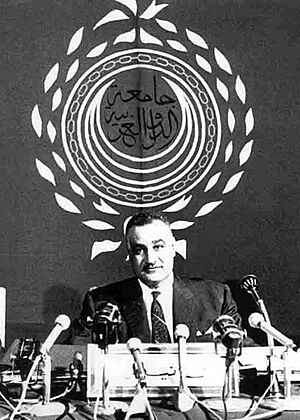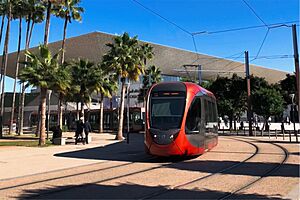History of Casablanca facts for kids
The city of Casablanca in Morocco has a long and interesting history. It has seen many changes in who governed it and what cultures influenced it. Over time, it was ruled by Berber, Roman, Arab, Portuguese, Spanish, French, British, and Moroccan leaders. Because it was an important port city, many different groups wanted to control it throughout its early history.
The city's first name was Anfa, which means "hill" in the Berber language. Locals used this name until a huge earthquake in 1755 destroyed the city. When Sultan Mohammed ben Abdallah rebuilt the city's old part (called the medina), he named it "ad-Dār al-Bayḍāʾ" in Arabic. This name is a direct translation of Casablanca, which means "White House" in Spanish. French forces took over the city in 1907 and started using the Spanish name, Casablanca. Today, Anfa is the name of a specific area within Casablanca, located west of the old medina.
Contents
Casablanca's Roman Past: Anfa
The famous writer Leo Africanus described Anfa as a large city built by the Romans on the ocean shore. He wrote this in his book Description of Africa in the 16th century.
The area where Casablanca stands today was first settled by Berber people around 1000 BC. It became a port used by the Phoenicians and later by the Romans.
The Romans arrived in 15 BC and created an important trading port. This port, later known as Anfa, was directly connected to Mogador Island in southern Mauritania. From there, the Romans got a special purple dye used for important Roman clothing. It's also likely that Juba II's journey to explore the Canary Islands and Madeira started from Anfa.
The Roman port, probably called Anfus in Latin, was part of a Berber kingdom that worked with Rome. Later, Emperor Caligula made Anfa part of the Roman Empire. However, this was mostly in name, as the main Roman border was further north. Roman Anfa continued to exist until the 5th century, when the Vandals conquered Roman North Africa.
A Roman shipwreck from the 2nd century was found with 169 silver coins. This shows how much the Romans valued this port for trade. There is also proof of oil trade with Roman cities like Volubilis and Tingis in the 3rd century. A small group of Christians, likely linked to Roman merchants, probably lived in the port city until the 5th or 6th century.
The Barghawata Kingdom
A large Berber tribe called the Barghawata settled in this area. They created their own independent Berber kingdom around 744 AD. This happened after a Berber revolt against the Umayyad Caliph. Their kingdom lasted until the Almoravids conquered them in 1068 AD.
One historian, Abou El Kassem El Ziani, said that the Zenatiyins, a Berber group, were the first to establish Anfa.
Later, the Almohad Sultan Abd al-Mu'min drove the Barghawata out in 1149. He replaced them with Arab tribes from the desert.
Early Modern Times
During the 14th century, under the Merinid Dynasty, Anfa became a more important port. In the early 15th century, it became independent again. It also became a safe place for pirates. In 1468, the Portuguese army, led by King Afonso V, captured and destroyed the city. The Portuguese used the ruins to build a military fort in 1515. The small village that grew around it was called "Casa Branca," meaning "White House" in Portuguese.
After a major battle where the Portuguese king Sebastian died, Portugal and Casablanca became part of the Iberian Union from 1580 to 1640. When Portugal became independent again in 1640, Casablanca remained a Portuguese outpost. But in 1755, a big earthquake destroyed the city, and the Portuguese left it.
The city and its medina (old town) as we know it today were founded in 1770 AD by Sultan Muhammad III ben Abdallah. With help from the Spanish, the town was named Casa Blanca (white house in Spanish), which was translated to Dar el Beida in Arabic.
The 19th Century
In the 1800s, Casablanca became a major supplier of wool to Britain's growing textile industry. This meant more ships came to the port. By the 1860s, about 5,000 people lived there, and by the late 1880s, the population grew to about 10,000. Casablanca grew partly because of a system where Moroccans were protected by European powers, making them more independent. Casablanca was also a main port for Jewish people moving from other parts of Morocco.
Casablanca remained a small port. Its population reached about 12,000 soon after the French arrived in 1906. By 1921, the population soared to 110,000, largely due to the growth of informal settlements called bidonvilles.
French Rule
French Takeover
After an agreement in 1906, a French company got the right to build modern ports in Casablanca and Asfi. Construction at the port of Casablanca started on May 2, 1907. A small railway was built from the port to a quarry to get stones for the breakwater. This railway passed over the Sidi Belyout necropolis, a sacred area for Moroccans. The French also started controlling customs.
On July 28, 1907, a group of local tribes, led by Hajj Hamou, demanded three things from the city's leader: remove French officers from customs, stop port construction, and destroy the railway.
The city leader delayed his decision. By July 30, tribesmen had entered the city and started a rebellion. They ambushed the train, killing the French, Spanish, and Italian workers on board and destroying the train.
This event was what the French were waiting for. From August 5-7, French warships attacked Casablanca. French troops landed, starting the invasion of Morocco from the west. The French then took control of Casablanca and the surrounding area. This began the process of colonization, though French control was not official until 1912.
City Growth and Planning
The city quickly grew beyond its old walls. New areas were built, including a West African quarter and many simple adobe houses. Inside the old walls, the Moroccan city had winding, often muddy streets and small squares.
Hubert Lyautey was the first French military governor in Morocco. In 1913, he asked Henri Prost to plan the cities. Prost's work in Casablanca was praised for its modern city planning. The "European city" spread eastward around Casablanca's medina, which the French called "the native city." The area just outside the medina's eastern walls, once a large market, was turned into Place de France, now known as United Nations Square. This square, with its clock tower built in 1908, marked the meeting point between the Moroccan medina and the new European city.
In 1915, the French held an exhibition in Casablanca. This showed French influence after the 1907 bombing and during ongoing conflicts. It was also a chance to show off Morocco's resources and crafts.
Casablanca's population grew rapidly after 1907. Part of this growth came from Europeans moving to the city. As the capital of French-ruled Morocco, Casablanca attracted European professionals, merchants, and settlers. The European population included French, Spanish, Italian, and Portuguese people. By 1914, Europeans made up 40% of Casablanca's total population. They had their own schools, churches, hospitals, and recreation places.
In 1930, Casablanca hosted a Formula One world championship race at the new Anfa Racecourse. In 1958, the race was held at the Ain-Diab circuit. In 1983, Casablanca hosted the Mediterranean Games.
Under Lyautey, Casablanca became Morocco's economic center and Africa's largest port. The city's street plan was designed by French architect Henri Prost. He placed the city center where the main market of Anfa used to be. From this point, all main streets spread out to the east and south.
In 1937-1938, a typhoid fever outbreak happened. Colonial authorities used this to take over certain areas in Casablanca. Informal settlements were cleared from the city center, and their residents were forced to move.
World War II
Casablanca was a very important port during World War II. In November 1942, the British and Americans launched a three-part attack on North Africa, called Operation Torch. The westernmost part of this attack was in Casablanca.
The troops landed before dawn on November 8, 1942, at three places in Morocco: Safi, Fedala (the largest landing), and Port Lyautey. It was hoped that the French would not fight back, so there were no initial bombings. This turned out to be a mistake, as French defenses caused many American casualties.
On the night of November 7, a pro-Allied general tried to take control from the French command in Morocco. He wanted to surrender to the Allies the next day. His forces surrounded the villa of General Charles Noguès, the French high commissioner. However, Noguès called loyal forces, who stopped the attempt. This also warned Noguès about the coming Allied invasion, and he quickly strengthened French defenses.
- Front pages of ''Le Petit Marocain''
At Safi, the goal was to capture the port to land tanks. The landings were mostly successful. They started without covering fire, hoping the French wouldn't fight. But when French coastal guns fired, Allied warships fired back. By the time General Ernest Harmon's troops arrived, French snipers had trapped the assault troops on Safi's beaches. Most landings were behind schedule. Aircraft from carriers destroyed a French truck convoy bringing reinforcements. Safi surrendered on the afternoon of November 8. By November 10, the remaining defenders were trapped, and most of Harmon's forces rushed to join the attack on Casablanca.
At Port-Lyautey, the landing troops were unsure of their location, and the second wave was delayed. This gave French defenders time to organize. The remaining landings happened under artillery fire. With air support from the carriers, the troops pushed forward and captured their targets.
At Fedala, bad weather disrupted the landings. The beaches again came under French fire after daybreak. Patton landed at 8:00 AM, and the beachheads were secured later that day. The Americans surrounded the port of Casablanca by November 10, and the city surrendered an hour before the final attack was planned.
Casablanca hosted the Casablanca Conference in 1943 (January 14-24). Here, Winston Churchill and Franklin D. Roosevelt discussed how the war was going. Casablanca was also the site of a large American air base. This base was used for all American aircraft going to Europe during World War II.
After the War
In April 1953, a propaganda film called Salut Casa! was shown at the Cannes Film Festival. It showed the French colonial government working to "civilize" the area. The French government called Casablanca a "laboratory of urbanism." A French city planner, Michel Écochard, was featured in the film, talking about how they were handling challenges like people moving into the city and rapid city growth.
In July of the same year, Morocco's group of modern architects had its own section at an international architecture conference. The architects from Morocco presented a detailed study of daily life in Casablanca's informal settlements. To consider these simple huts, built by poor immigrants, worthy of study was a very new and bold idea. It even caused disagreements among modern architects.
Young architects like Shadrach Woods and Georges Candilis worked in Casablanca. They designed modular public housing units that considered local ways of life. Elie Azagury, the first Moroccan modernist architect, led the Moroccan architects' group after Morocco gained independence in 1956.
Moving Towards Independence
During the 1940s and 1950s, Casablanca was a major center for the fight against colonial rule.
In 1947, the Sultan went to Tangier to give a speech asking for independence. French colonial forces then caused a conflict between Senegalese soldiers working for the French and Moroccan locals. This was an attempt to stop the Sultan's trip. This event, known as Darbat Salighan, lasted about 24 hours from April 7-8, 1947. The soldiers fired randomly into homes, killing between 180 and 1000 Moroccan civilians. The Sultan returned to Casablanca to comfort the victims' families, then went to Tangier to give his important speech.
The killing of Tunisian labor union leader Farhat Hached by a secret French intelligence group sparked protests worldwide and riots in Casablanca from December 7-8, 1952. A general strike was organized in a working-class neighborhood on December 7.
On December 24, 1953, in response to violence from French colonists and the forced exile of Sultan Mohammed V, Mohammed Zerktouni planned the bombing of the Central Market. This attack killed 16 people.
Since Independence
Morocco became independent from France on March 2, 1956.
Casablanca Group Meeting
From January 4-7, 1961, Casablanca hosted a meeting of important African leaders. King Muhammad V welcomed leaders like Gamal Abd An-Nasser of Egypt, Kwame Nkrumah of Ghana, and Modibo Keïta of Mali. This conference led to the creation of the pan-Africanist Casablanca Group, which later contributed to the African Union.
Jewish Emigration
Casablanca was a main departure point for Jewish people leaving Morocco. Between November 1961 and spring 1964, a secret operation helped Moroccan Jews move to Israel.
1965 Riots
The 1965 student protests, which turned into riots, began on March 22, 1965, in front of a high school in Casablanca. About 15,000 students were there. The protests started as a peaceful march to demand the right to public higher education, but they were violently broken up. The next day, students returned with workers and unemployed people. They damaged stores, burned buses and cars, threw stones, and chanted slogans against King Hassan II. The king had gained more political power since 1961.
The riots were stopped by tanks for two days. A general even fired into the crowd from a helicopter.
The king blamed teachers and parents for the events. In a speech on March 30, 1965, he said, "Allow me to tell you that there is no greater danger to the State than a so-called intellectual. It would have been better if you were all illiterate."
1965 Arab League Summit
A secret meeting of the Arab League was held in Casablanca in September 1965. An Israeli intelligence officer said that King Hassan II invited Israeli agents to bug the hotel where the conference was held. This allowed them to record conversations of the Arab leaders. This information was very helpful to the Israelis in their military victories against Egypt, Jordan, and Syria in the Six-Day War. Before the war, King Hassan II had a working relationship with Israeli intelligence. They had helped him in France to kidnap a Moroccan leftist leader.
Years of Lead
During a period known as the "Years of Lead," a prison in Casablanca was used to question people who disagreed with King Hassan II. A poet and activist died there in 1977 after a hunger strike.
The music of a group called Nass El Ghiwane represented some of the art created to oppose the strict government.
1981 Riots
On May 29, 1981, riots broke out in Casablanca. Morocco was struggling from a war in the Western Sahara. A general strike was organized because of increases in the cost of basic foods. Thousands of young people from the informal settlements around Casablanca formed groups. They threw stones at symbols of wealth, including buses, banks, pharmacies, grocery stores, and expensive cars. Police and military units fired into the crowds. The government said 66 people died, while the opposition reported 637 deaths, mostly young people from the slums who were shot. This uprising was the first of two "Hunger Revolts" in Morocco.
Modern Casablanca
The first McDonald's restaurant in Africa and the Arab world opened in Casablanca in 1992.
The city is now developing its tourism industry. Casablanca has become the economic and business capital of Morocco, while Rabat is the political capital.
In March 2000, women's groups organized protests in Casablanca. They asked for changes to the legal status of women in the country. 40,000 women attended, calling for a ban on polygamy (having more than one spouse) and the introduction of divorce law. Although a counter-protest attracted half a million people, the movement for change influenced King Mohammed VI. He enacted a new family law in early 2004, meeting some of the demands of women's rights activists.
The first line of the Casablanca Tramway opened in December 2012. As of 2019, it has two lines. Al-Boraq, a high-speed train service connecting Casablanca and Tangier, was opened on November 15, 2018. It is the first high-speed rail service in Africa.
See also
- Acheulean
- Aterian
- Mesolithic
- Mousterian
- Timeline of Casablanca


